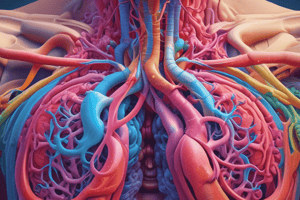Podcast
Questions and Answers
What is the primary purpose of the respiratory system?
What is the primary purpose of the respiratory system?
- To supply oxygen and eliminate carbon dioxide. (correct)
- To filter and moisten incoming air.
- To carry food and water to the digestive system.
- To produce energy from glucose without oxygen.
What role do ciliated cells play in the nasal passages?
What role do ciliated cells play in the nasal passages?
- They help in the exchange of gases.
- They absorb carbon dioxide from the air.
- They secrete enzymes to break down food.
- They filter and moisten incoming air. (correct)
What is the function of the epiglottis?
What is the function of the epiglottis?
- To bring air into the nasal passages.
- To produce sound during speech.
- To cover the trachea during swallowing. (correct)
- To transport oxygen to the lungs.
Which structure is known as the voice box?
Which structure is known as the voice box?
Why is the diaphragm important for respiration?
Why is the diaphragm important for respiration?
What are turbinate bones responsible for in the respiratory system?
What are turbinate bones responsible for in the respiratory system?
What is the main purpose of the pleural membranes?
What is the main purpose of the pleural membranes?
How do gases exchange in the alveoli?
How do gases exchange in the alveoli?
What causes adolescent boys to struggle with controlling the pitch of their voice following puberty?
What causes adolescent boys to struggle with controlling the pitch of their voice following puberty?
Which statement describes the function of cilia in the respiratory tract?
Which statement describes the function of cilia in the respiratory tract?
What is the primary function of the trachea?
What is the primary function of the trachea?
Which structure is primarily responsible for the gas exchange process in the lungs?
Which structure is primarily responsible for the gas exchange process in the lungs?
Which muscle aids in breathing movements by separating the thoracic cavity from the abdominal cavity?
Which muscle aids in breathing movements by separating the thoracic cavity from the abdominal cavity?
What is the purpose of the pleural membrane surrounding the lungs?
What is the purpose of the pleural membrane surrounding the lungs?
How are the bronchi supported structurally?
How are the bronchi supported structurally?
What role do intercostal muscles play in the respiratory system?
What role do intercostal muscles play in the respiratory system?
What characteristic distinguishes bronchioles from other parts of the respiratory system?
What characteristic distinguishes bronchioles from other parts of the respiratory system?
Which statement is true regarding the lobes of the lungs?
Which statement is true regarding the lobes of the lungs?
Flashcards
Nasal Passages
Nasal Passages
The part of the respiratory system that filters and moistens incoming air.
Turbinate Bones
Turbinate Bones
Thin, curved bones in the nasal cavity increasing surface area for air warming and filtering.
Pharynx
Pharynx
The throat; a passageway for air and food.
Epiglottis
Epiglottis
Signup and view all the flashcards
Trachea
Trachea
Signup and view all the flashcards
Larynx
Larynx
Signup and view all the flashcards
Vocal Cords
Vocal Cords
Signup and view all the flashcards
Cellular Respiration
Cellular Respiration
Signup and view all the flashcards
Larynx Growth in Males
Larynx Growth in Males
Signup and view all the flashcards
Trachea Function
Trachea Function
Signup and view all the flashcards
Cilia Function
Cilia Function
Signup and view all the flashcards
Bronchi Function
Bronchi Function
Signup and view all the flashcards
Bronchioles Structure
Bronchioles Structure
Signup and view all the flashcards
Alveoli Function
Alveoli Function
Signup and view all the flashcards
Lungs Function
Lungs Function
Signup and view all the flashcards
Pleural Membrane Function
Pleural Membrane Function
Signup and view all the flashcards
Diaphragm Function
Diaphragm Function
Signup and view all the flashcards
Intercostal Muscles Function
Intercostal Muscles Function
Signup and view all the flashcards
Study Notes
Respiratory System Structures
- The respiratory system is responsible for supplying oxygen to body cells and removing carbon dioxide.
- Main structures include nasal passages, pharynx, larynx, epiglottis, trachea, bronchi, bronchioles, alveoli, diaphragm, rib muscles, and pleural membranes.
Respiration Definition
- Respiration encompasses all processes bringing oxygen to cells for glucose breakdown and carbon dioxide removal.
- Respiration involves gas exchange between an organism and its environment.
- Cellular respiration is the process where cells break down fuel molecules to produce energy and release carbon dioxide.
Cells and Oxygen
- Cells require oxygen to perform essential survival processes, notably producing ATP (energy).
- Carbon dioxide is a waste product of these processes and must be expelled.
Respiratory Tract Structures
- The respiratory tract includes the nasal passages, pharynx, larynx, epiglottis, trachea, bronchi, bronchioles, and alveoli.
- The pharynx serves as a pathway for both air and food.
- The epiglottis covers the trachea opening during swallowing, preventing food from entering the lungs.
- The larynx contains the vocal cords.
- The trachea, reinforced with cartilage rings, carries air to the bronchi.
- The bronchi branch into bronchioles, smaller airways leading to alveoli.
- Alveoli are tiny air sacs where gas exchange occurs.
Structures and Functions of Nasal Passages
- Nasal passages are lined with cells that filter, moisten, and warm incoming air.
- Turbinate bones increase the surface area for these processes.
- The heating of air is done by blood vessels.
Structures and Functions of Turbinates and Cilia
- Turbinate bones are thin, curved, bony plates inside the nasal cavity increasing surface area for air filtering.
- Cilia are tiny, hair-like structures that line the respiratory tract and move mucus and trapped particles away from the lungs.
Structures and Functions of Pharynx
- The pharynx, or throat, is a pathway for both air and food.
- Two openings branch from the pharynx: the esophagus (to the stomach) and the trachea (to the lungs).
Structures and Functions of Epiglottis
- The epiglottis is a flap of cartilage that closes the trachea opening during swallowing to prevent food from entering the lungs.
- This prevents unwanted substances from entering the lungs.
Structures and Functions of Larynx
- The larynx is the voice box, containing the vocal cords that vibrate to produce sound.
- The Adam's apple is cartilage protecting the larynx.
- The vocal cords vibrate due to airflow.
Differences Between Male and Female Larynges
- Males' larynges typically enlarge more at puberty, resulting in a larger Adam's apple and often a deeper voice.
Trachea and Bronchi
- The trachea, or windpipe, is supported by C-shaped rings of cartilage and lined with cilia.
- It transports air to the bronchi.
- Bronchi, similar to the trachea, carry air to the lungs.
Bronchioles
- Bronchioles are smaller airways inside the lungs, without cartilage support.
Alveoli
- Alveoli are tiny air sacs at the end of bronchioles where gas exchange occurs.
- They are the site of gas exchange, facilitating oxygen uptake and carbon dioxide release.
Lungs
- Lungs are primary organs of respiration, divided into lobes (3 lobes in right lung, 2 lobes in left lung–to accommodate the heart).
Pleural Membrane
- The pleural membrane is a thin, fluid-filled membrane that surrounds the lungs and reduces friction during breathing.
- It facilitates smooth lung expansion.
Diaphragm
- The diaphragm is a dome-shaped muscle below the lungs.
- It aids in breathing by contracting and relaxing during inhalation and exhalation.
Intercostal Muscles
- Intercostal muscles are located between the ribs.
- They help with rib movement, aiding the diaphragm in inhalation and exhalation.
Oxygen's Role in Survival
- Oxygen is crucial for cellular respiration, a process that provides energy for life functions.
Cilia Function
- Cilia in the respiratory tract sweep mucus and trapped particles upward toward the pharynx for removal.
Related Functions of Trachea, Esophagus, and Epiglottis
- These structures are related by their coordinated actions in preventing food from entering the lungs and ensuring smooth airflow.
- The epiglottis covers the trachea during swallowing, and the esophagus allows food passage.
Difference Between Breathing and Cellular Respiration
- Breathing is the physical process of taking in air (inhalation) and releasing air (exhalation).
- Cellular respiration is a metabolic process where cells utilize oxygen to create energy.
Studying That Suits You
Use AI to generate personalized quizzes and flashcards to suit your learning preferences.




